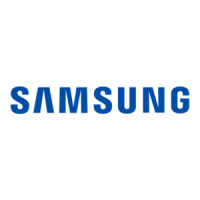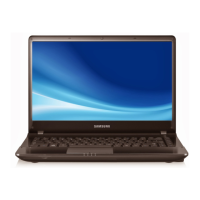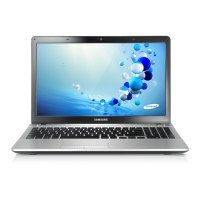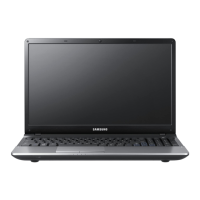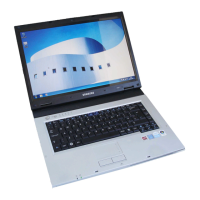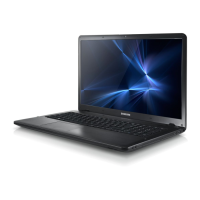
Do you have a question about the Samsung NP350E7C and is the answer not in the manual?
| Bus type | DMI |
|---|---|
| Stepping | E1 |
| Tjunction | 105 °C |
| Processor cache | 6 MB |
| Processor cores | 4 |
| Processor model | i7-3630QM |
| System bus rate | 5 GT/s |
| Processor family | Intel® Core™ i7 |
| Processor series | Intel Core i7-3600 Mobile series |
| Processor socket | PGA988 |
| Processor threads | 8 |
| Processor codename | Ivy Bridge |
| Processor frequency | 2.4 GHz |
| Processor cache type | Smart Cache |
| Processor lithography | 22 nm |
| Processor manufacturer | Intel |
| Processor front side bus | - MHz |
| PCI Express slots version | 3.0 |
| Processor boost frequency | 3.4 GHz |
| Processor operating modes | 64-bit |
| ECC supported by processor | No |
| PCI Express configurations | 1x16, 2x8, 1x8+2x4 |
| Thermal Design Power (TDP) | 45 W |
| CPU multiplier (bus/core ratio) | 24 |
| Maximum number of PCI Express lanes | 16 |
| Motherboard chipset | Intel HM76 Express |
| Memory slots | 2x SO-DIMM |
| Internal memory | 8 GB |
| Memory clock speed | 1600 MHz |
| Internal memory type | DDR3-SDRAM |
| Maximum internal memory | - GB |
| Memory slots (available) | 0 |
| Memory layout (slots x size) | 2 x 4 GB |
| HDD speed | 5400 RPM |
| HDD interface | SATA II |
| Storage media | HDD |
| Optical drive type | DVD Super Multi DL |
| Card reader integrated | Yes |
| Total storage capacity | 1000 GB |
| Compatible memory cards | SD, SDHC, SDXC |
| Display diagonal | 17.3 \ |
| Display resolution | 1600 x 900 pixels |
| Native aspect ratio | 16:9 |
| On-board graphics card ID | 0x166 |
| Discrete graphics card model | AMD Radeon HD 7670M |
| On-board graphics card model | Intel® HD Graphics 4000 |
| Discrete graphics card memory | 2 GB |
| Discrete graphics memory type | GDDR3 |
| On-board graphics card family | Intel® HD Graphics |
| Number of discrete graphics cards | 1 |
| On-board graphics card base frequency | 650 MHz |
| On-board graphics card dynamic frequency (max) | 1150 MHz |
| LightScribe | - |
| Audio system | SoundAlive |
| Speaker power | 1.5 W |
| Number of built-in speakers | 2 |
| Front camera resolution (numeric) | 1.3 MP |
| Wi-Fi standards | 802.11b, 802.11g, Wi-Fi 4 (802.11n) |
| Bluetooth version | 4.0 |
| Networking standards | IEEE 802.11b, IEEE 802.11g, IEEE 802.11n |
| Ethernet LAN data rates | 10, 100, 1000 Mbit/s |
| Charging port type | DC-in jack |
| USB 2.0 ports quantity | USB 2.0 ports have a data transmission speed of 480 Mbps, and are backwards compatible with USB 1.1 ports. You can connect all kinds of peripheral devices to them. |
| Keyboard layout | QWERTY |
| Bundled software | S Player, S Gallery, S Camera, PowerDVD, Settings \\r Support Centre, SW Update, Recovery, Norton Internet Security (60 days Trial), Norton Online Backup (30 days Trial) \\r ※ Software can be changed without notice |
| Operating system installed | Windows 8 |
| Form factor | Clamshell |
| Product type | Laptop |
| Product color | Black |
| Battery capacity | 48 Wh |
| Battery life (max) | - h |
| Number of battery cells | 6 |
| AC adapter power | 90 W |
| Processor code | SR0UX |
| Processor ARK ID | 71459 |
| Processor package size | 37.5 x 37.5 (rPGA988B) mm |
| Supported instruction sets | AVX |
| Intel Identity Protection Technology version | 1.00 |
| Depth | 270.2 mm |
|---|---|
| Width | 411.3 mm |
| Height | 35.2 mm |
| Weight | 2800 g |
Initial steps and important information before using the computer.
Crucial instructions to prevent injury and product damage.
Step-by-step guide for powering the computer on and off.
Overview of the Start screen and Desktop modes in Windows 8.
Explains how to activate and use the Charms menu for quick access.
Guide on how to start, exit, and manage applications in Windows 8.
Details on keyboard functions, shortcut keys, and other keys.
Explains touchpad operations including clicks, drags, scrolls, and gestures.
Instructions for connecting monitors or TVs via D-SUB or HDMI ports.
Steps for connecting to a wired LAN and configuring network settings.
Guide to connecting to wireless networks and accessing APs.
Process for updating Samsung software and drivers.
Using the Support Center to diagnose issues and find solutions.
Guide on entering and navigating the BIOS setup utility.
Steps for setting supervisor, user, and HDD passwords for system security.
Information on installing, removing, charging, and managing the battery.
Procedures for backing up data and restoring the system to factory settings.
Guide for reinstalling Windows using recovery media or the built-in solution.
Frequently asked questions and answers related to system operation and Windows 8.
Essential safety guidelines for system setup and usage.
Details on compliance with national and international standards and regulations.
Technical details of the computer's hardware components and operating environment.
Definitions of technical terms used throughout the user guide.
